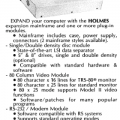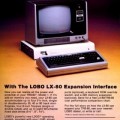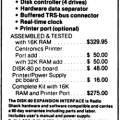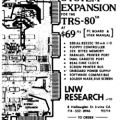The Radio Shack Expansion Interface
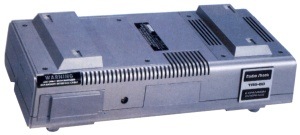
Expansion Interface from a Radio Shack catalog
The Radio Shack TRS-80 Model I had few options for internal expansion other than adding a maximum of 16K of internal memory. The external expansion possibilities were reserved for a device Radio Shack called the Expansion Interface.
Introduced in 1978, the Radio Shack Expansion Interface plugged into the back of the Model I using a six-inch long cable and was designed to serve as a base for the TRS-80 monitor. It provided:
- sockets for 32K of extra memory (for a maximum of 48K when combined with the 16K internal to the Model I)
- a floppy disk controller
- a heartbeat counter for measuring time
- a parallel port for a printer
- ports for two cassette recorders
- an “Expansion Board Compartment” (missing from some early Expansion Interfaces) used primarily for an optional RS-232 card
- a bus card-edge which duplicated the signals on the Model I card-edge
The Expansion Interface came with its own external power supply that was identical to the one used by the Model I. There was a “storage compartment” in the Expansion Interface that could hold both power supplies. Each unit came with cover-plates protecting all of the ports. Most users discarded those cover-plates when they plugged in their peripherals, so the plates tend to be missing today.
Configurations
Radio Shack sold the Expansion Interface in three configurations:
- 26-1140: 0K (no memory) for $299.00
- 26-1141: 16K for $448.00 (reduced to $398.00 by 1982)
- 26-1142: 32K for $597.00 (reduced to $497.00 by 1982)
Radio Shack stated that the catalog number of an Expansion Interface changed when the memory was upgraded, even if it was a user memory upgrade.
One odd detail about the Expansion Interface was that even though users were left with three cassette plugs (one on the TRS-80 and two on the Expansion Interface), only two worked at one time. The Expansion Interface manual pointed this out:
If you have just one recorder, leave it connected directly to the CASSETTE jack on the TRS-80. There is no advantage in having a single recorder connected via the Expansion Interface.
Reliability
The Model I and Expansion Interface combination worked well for many users. Unfortunately, this wasn’t true for everyone and many Expansion Interface combinations exhibited reliability problems in ordinary use. Spontaneous reboots, lockups, and crashes were common occurrences with those units.
According to Dennis Báthory-Kitsz in his excellent book The Custom TRS-80 and Other Mysteries, the problem areas involved:
- memory refresh/select
- noisy and dirty connectors
- weak buffering lines
- microphonics
- susceptibility to external interference.
Most of the problems were related to the fact that all of the processor signals (including timing and memory accesses) were sent from the Model I to the Expansion Interface over an unshielded six-inch cable. This cable was very susceptible to electronic noise and any interference to the signals would crash the computer.
Radio Shack tried three different solutions to the problems:
- First, they tried buffered cables which had special circuitry inside to amplify the signals and reduce noise.
- Next, they tried the “DIN cable modification”, which separated the crucial memory signals from the main cable into another three-pin cable with DIN connectors.
- When neither solution corrected all of the problems, they redesigned the Expansion Interface itself.
Redesign
Starting in January 1980, Radio Shack started selling the redesigned Expansion Interface. The new units didn’t require a buffered or DIN-modified cable (and using one was not a good idea).
Among other things, the redesign greatly reduced electrical noise and placed buffers directly on the Expansion Interface board. Another change was that only one memory signal (RAS) was sent to the Expansion Interface through the cable. The other two memory signals were derived from RAS. This caused problems for some Model I speed-up kits that required all three signals.
The problems many people experienced with the Radio Shack Expansion Interface led several companies, including LNW and Exatron, to design and sell their own alternatives. These third-party Expansion Interfaces didn’t exhibit from the same problems as the Radio Shack version and were preferred by many users.
Discontinuation
Radio Shack discontinued the Model I on January 1, 1981 rather than redesign it to meet new FCC regulations governing radio frequency interference. But the FCC gave Radio Shack an exemption to manufacture 30,000 Expansion Interfaces in 1981. They weren’t allowed to make any more, but Radio Shack continued to list the Expansion Interface in their catalogs until the entire inventory was sold.
The lessons of the problems with the Expansion Interface were heeded by the Radio Shack engineers: the Model I was ultimately replaced with the Model III, designed to be expandable internally without requiring any Expansion Interface.
